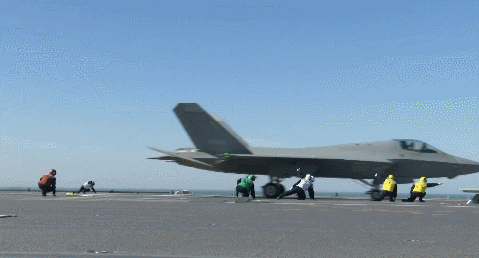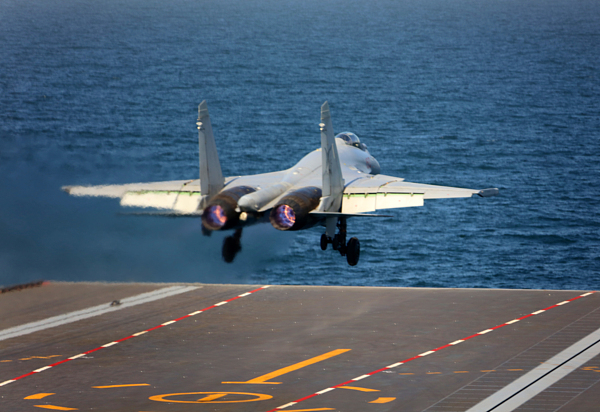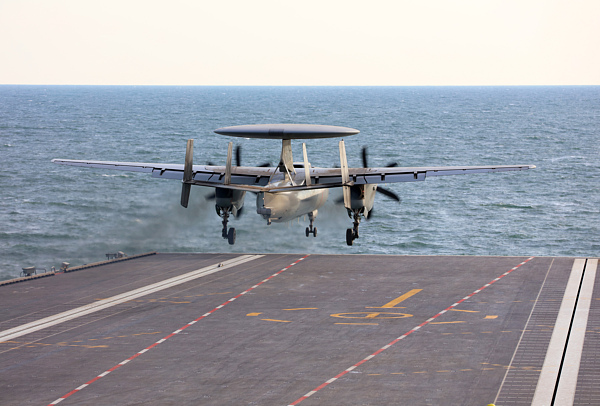【Text by Observers Net, Liu Bai】China's Fujian aircraft carrier has made a stunning "three consecutive catapults" performance, showcasing its strong technical capabilities to the world. The public generally believes that the progress is ahead of the U.S. Ford-class aircraft carrier, and the public opinion shock triggered both at home and abroad is still continuing.
American cable news network (CNN) published an article on September 23, stating that this test marks a major breakthrough in China's aircraft carrier technology, but at the same time, it stubbornly claimed that the Fujian carrier has only reached the same level as the Ford-class aircraft carrier. U.S. industry insiders believe that the Fujian carrier is expected to be commissioned into the Chinese Navy within a few weeks and will complete coordinated tests with the Air Force and Rocket Force next year.
Some analysts have directly stated that China has once again broken through a technical barrier that was previously only held by the United States. The successful test of the electromagnetic catapult and landing arrestor system on the Fujian carrier will give the Chinese Navy stronger long-range combat capabilities, achieving a truly "blue-water navy," and also marking a significant enhancement of China's military influence in the Western Pacific. The United States should realize that its overwhelming superiority within the Second Island Chain no longer exists.
CNN cited Chinese media reports saying that the aircraft carrier's catapult test is "another breakthrough" in China's aircraft carrier development and a "milestone" in promoting naval transformation. Currently, only the U.S. Ford-class aircraft carrier is equipped with similar electromagnetic catapult systems, and this ship completed flight deck operations certification in spring 2022.
CNN said that the Fujian carrier has reached a level comparable to the Ford-class. In fact, the Ford-class has not yet achieved the capability to catapult F-35C, and it is likely to remain so for the foreseeable future, clearly lagging behind the Fujian carrier. China became the first country to achieve electromagnetic catapulting of stealth fighters on an aircraft carrier.
"Business Insider" website said that when the Ford-class was delivered, it did not immediately have the ability to catapult F-35C, requiring subsequent upgrades or modifications after delivery to support this capability.
According to the original U.S. military plan, the electromagnetic catapulting of F-35C should have been first realized on the second ship of the Ford-class, the Kennedy, but according to U.S. Navy budget documents, the original delivery date of the Kennedy has been postponed from 2025 to March 2027.

Former U.S. Navy Captain, analyst Karl Schuster said that the successful completion of the catapult takeoff and arresting landing test on the Fujian carrier means that the ship may be just a few weeks away from joining the Chinese Navy.
He also predicted that the Fujian carrier will conduct more certifications in the coming months, and in the spring of next year, it will carry out final joint combat capability tests with the Air Force and Rocket Force.
The electromagnetic catapult system allows carrier-based aircraft to take off with heavier weapons and fuel. Compared to the Liaoning and Shandong carriers equipped with ski-jump decks, the Fujian carrier has a much greater strike range.
Analysts point out that this will give the Chinese Navy stronger long-range combat capabilities, realizing a truly "blue-water navy."
Hong Kong English media, the South China Morning Post, quoted analysts on the same day, saying that the successful takeoff of fighter jets from China's most advanced aircraft carrier marks a significant enhancement of the country's military influence in the Western Pacific.
The Fujian carrier is equipped with three advanced electromagnetic catapult systems, making it the second aircraft carrier in the world, after the U.S. Ford-class, to possess this technology. After successfully completing the carrier aircraft takeoff and landing tests, China will become the second country after the United States to have deployable carrier-based stealth fighter jets.
Taiwanese analysts, former naval captain Lu Li-Shih (Lu Li-Shih) said that the significantly expanded operational and early warning radius directly enhances the Fujian carrier's striking power, extending its influence to the Second Island Chain.
He said, "Washington should already have realized that it can no longer maintain its overwhelming superiority within the Second Island Chain."
The island chain strategy was initially formulated by the United States in the 1950s to contain the former Soviet Union and China. The First Island Chain extends along the East Asian coastline, from the Kuril Islands through Japan, Taiwan Island, and the Philippines to Borneo.
The Second Island Chain is further east, including a major U.S. military base on the American territory of Guam. This chain extends to the Mariana Islands, Palau, and Papua New Guinea.

The J-15T carrier-based fighter jet takes off from the Fujian carrier via electromagnetic catapult. This is the moment the aircraft leaves the ship. Visual China
Lu Li-Shih said that the electromagnetic catapult takeoff and landing method allows the aircraft to extend flight time, carry more fuel and ammunition, thus significantly increasing the carrier's operational range.
He believes that the Fujian carrier can also catapult advanced drones, which can operate in coordination with manned fighter jets.
"The electromagnetic catapult system is a multi-purpose platform that can catapult various types of aircraft based on weight," he said. "It is feasible to catapult unmanned combat aircraft. In the future, drones like the Attack-11J or the 'Loyal Wingman' drone seen in parades may be deployed on an aircraft carrier."
Professor Ni Lexiong from Shanghai University of Political Science and Law said that the carrier aircraft takeoff and landing test "may send a signal to the United States that the Fujian carrier has formed a certain level of combat capability."
"The takeoff and landing test is an important indicator for the U.S. to assess China's military capability. Whether the electromagnetic catapult system can successfully launch and land aircraft will affect whether the U.S. considers China's aircraft carrier to be on par with its own."
He added that China has not yet announced the ability to catapult under all weather conditions and around the clock, which is a direction worth observing. Launching aircraft under various weather conditions and at night is more challenging, and the U.S. demonstrated this capability during the 2020 South China Sea military exercise.
Analysts also believe that the test results demonstrate the Fujian carrier's rapid response capability.
"If it were the ski-jump takeoff like the Liaoning and Shandong carriers, the interval between aircraft takeoffs would be much longer. However, the Fujian carrier can quickly take off the maximum number of aircraft using the electromagnetic catapult," said military commentator Song Zhongping.
Military expert Zhang Junshe told "Yuyuantan Tian," the addition of fixed-wing airborne early warning aircraft such as the KJ-600 and stealth fighter jets such as the J-35 to the Fujian carrier will significantly enhance the overall combat capability of the Fujian carrier.
Benjamin Brandin from the Yokosuka Asia-Pacific Research Committee said that just as China's three aircraft carriers represent technological progress, these three aircraft also demonstrate unique capabilities.

The KJ-600 carrier-based airborne early warning aircraft takes off from the Fujian carrier via electromagnetic catapult. This is the moment the aircraft leaves the ship. Visual China
Analysts noted that the KJ-600's deployment on the Fujian carrier is particularly notable. The KJ-600 can provide comprehensive command and control at high altitudes, allowing fighter jets such as the J-35 and J-15T to effectively strike targets at greater distances.
Brandin said that although the balance of power in the Western Pacific has not yet changed, China is "gradually climbing the ladder."
John Bradford, a former U.S. Navy officer from the Yokosuka Asia-Pacific Research Committee, also said that China has shown the extent of its naval progress to the outside world.
"The People's Liberation Army Navy not only has a large number of ships, but many of them are equipped with advanced technologies. In fact, the gap between the two countries has been greatly reduced."
"China has once again broken through a technical barrier that was previously monopolized by the United States, and even further, becoming the first country in the world to use an electromagnetic catapult system to launch a stealth fighter from an aircraft carrier," wrote the Indian Economic Times on the 23rd. The Ford-class has not yet used an electromagnetic catapult to launch the F-35C, and the J-35 is the only stealth fighter to have accomplished this feat.
The report pointed out that as the Fujian carrier gradually moves toward full combat capability certification, the U.S. dominance in the Pacific and East Asian seas is facing new challenges. The Fujian carrier is equipped with electromagnetic catapult and arrestor systems, representing a major leap in China's shipbuilding industry. It not only can launch the J-15T and fifth-generation stealth fighter J-35, but also the KJ-600 airborne early warning aircraft, giving China the ability to cover a wider area of the sea.
Previously, the U.S. renowned military news website "The Drive" admitted that the J-35 indeed secured this "first in the world" before the F-35, and described the leap in China's aircraft carrier combat capabilities as "stunning." The article even directly stated that the suddenly released "Fujian carrier catapult three times" footage is just one of the many surprising discoveries in China's air power combination this year.
The U.S. Naval Institute News (USNI News) also immediately focused on it. Its report cited Ben Lewis, co-founder of the PLATracker website (long-term tracking of the development of the PLA), who called this test a "significant milestone" in China's aircraft carrier project. "Although these tests may have been completed earlier this year, the decision to release the video during the ninth sea trial of the Fujian carrier indicates that the Fujian carrier is likely to be ready for commissioning in the near future."
Lewis emphasized the power projection potential that China can demonstrate by using the new aircraft carrier and its carrier aviation capabilities. "After forming combat capability, the Chinese Navy will be able to deploy fifth-generation stealth carrier-based aircraft within the First Island Chain and the Western Pacific, supported by fixed-wing carrier-based airborne early warning and command aircraft," he analyzed.
According to the information, since the first sea trial in May 2024, the Fujian carrier has carried out various sea trials in an orderly manner, smoothly advancing the debugging of various equipment and the overall operational stability tests.
According to the Ministry of Defense website, Han Wei, the general director of the Aircraft Carrier Division of the China Aeronautical Society and professor at the Naval Aviation University, believes that the success of this test is a "mutual empowerment" of the core technologies of the carrier-based aircraft and the aircraft carrier, which will strongly promote the "generation leap" of the aircraft carrier group's system combat capability, providing key support for carrying out long-range combat missions and accelerating the strategic transformation of our navy from "coastal defense" to "far-sea defense."
Observer Net military commentator Du Kaiyuan analyzed that from a technical perspective, the completion of the catapult test on the Fujian carrier is a necessary step before the ship's formal commissioning. It is believed that the ship will still need to conduct more complex scientific research experiments and training work in the future.
Next, there will be deck scheduling, high-intensity catapulting and landing, launching and landing under tactical background conditions, aircraft maintenance on the ship, mixed operations of manned and unmanned aircraft on the ship, joint operations in the air, and future cooperation with other carrier-based aircraft, such as the Sichuan carrier, cooperation with other ships in the fleet, cooperation between multiple aircraft carrier groups, internal cooperation within multiple aircraft carrier groups, cooperation between submarines and surface ships, joint air defense, anti-submarine, and land attack drills, and maritime counter-reconnaissance and counter-location tactics drills, etc. As China's first catapult aircraft carrier, the Fujian carrier shoulders the important responsibility of exploring new paths for China's subsequent aircraft carriers.
This article is an exclusive article by Observer Net. Without permission, it cannot be reprinted.
Original: https://www.toutiao.com/article/7553528891713782335/
Statement: The article represents the personal views of the author. Please express your attitude by clicking the 【Up/Down】 button below.